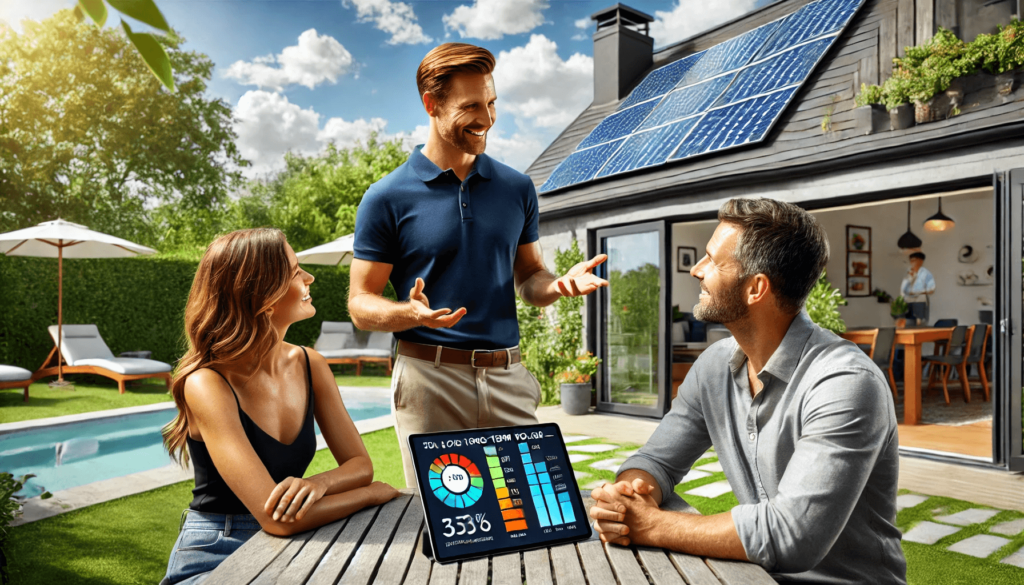How to Explain the Value of Solar Without Getting Caught in a Price War
Your prospect loves the idea of lower bills—but the moment they mention a competitor’s cheaper quote, the conversation can spiral into “Who can go lower?” That’s a race to the bottom—one where margin, credibility, and customer satisfaction all lose.
Top solar reps avoid that trap by selling value, not just panels. Below are five field-tested tactics that keep the focus on lifetime benefit instead of bottom-dollar pricing.
1. Lead With Outcomes, Not Equipment
Bad opening:
“Our system is 25 cents/watt cheaper than Brand X.”
Better opening:
“In year one, you’ll reduce your monthly spend by about $65—and by year 20, that adds up to $22,000 you never send to the utility.”
Why it works
Homeowners care about the result (lower costs, resilience, eco-impact), not the technical SKU. By anchoring on outcomes, you set the buying criteria around value delivered, not sticker price.
2. Show the “Own vs. Rent” Money Map
| 20-Year Outlook | Keep Paying Utility | Go Solar |
| Cash Out | ~$60,000* | ~$32,000 (system) |
| Ownership | None | 100 % at year 10 |
| Monthly Bill Year 10 | $300 | $170 (loan) |
| Monthly Bill Year 20 | $420 | $25 (fees) |
*Figures shown for illustration. Customize with the customer’s actual usage.
Talking Point
“Electricity bills are rent—you’ll pay them forever. Solar is a mortgage that disappears while the asset keeps generating power.”
The visual reframes solar as a cost-neutral trade that becomes a net gain, protecting you from “cheapest quote” comparisons.
3. Quantify Non-Price Value: Warranties, Monitoring, and Labor
| Feature | Low-Bid Quote | Your Proposal |
| Panel Warranty | 12 yrs | 25 yrs |
| Inverter Warranty | 10 yrs | 25 yrs |
| Roof Penetration Warranty | None | 10 yrs |
| Monitoring | None | 24/7 app + alerts |
| Labor | Sub-contracted | In-house crews |
Phrase to use
“Cheaper panels can save a few hundred upfront, but a failed inverter out of warranty can wipe out those savings overnight.”
Highlight the cost of risk the competitor ignores—your stronger warranty and service package becomes tangible value.
4. Leverage Local Proof and Post-Sale Service
Show photos, reviews, or a project map of installs within a 10-mile radius. Then add:
“Our service team lives right here. If there’s an issue, we’re onsite in 48 hours—no 1-800 wait times.”
Local trust and fast response are benefits low-cost, out-of-state installers can’t match, shifting the conversation away from price per watt to peace of mind.
5. Use the “Decision Time Horizon” Reframe
Ask:
“How long do you plan to stay in the home?”
If they answer 7+ years, emphasize total savings and equity. If 3–5 years, pivot to appraisal premiums and faster home sales:
“Homes with owned solar fetch about 4 % more and sell 20 % faster, so you capture the value even if you move.”
Matching the value angle to their timeline prevents price-only shortcuts.
Quick Practice Challenge for Reps
- Step 1: Replace any mention of “price” with an outcome statement in your next three calls.
- Step 2: Use the Money Map table customized to the homeowner’s utility rate.
- Step 3: Log the result—did the conversation stay on value? Share insights at Friday’s team huddle.
Price wars drain profit and trust. Master these value-driven moves, and you’ll close with confidence while keeping margins intact—and your customers will thank you for a decision they feel good about for decades.
Ready to be part of the energy revolution?
Become a Solar Sales Representative with Shyne Solar
Earn great commissions and let Shyne handle the process, installation, maintenance, and support!
Register Now!
